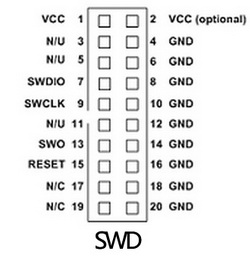Details

Overview
Core407Z is a small STM32 development board that features an STM32F407ZxT6 device as the microcontroller, supports further expansion. It is ideal for starting application development with STM32F family.
As a minimal ready-to-run system, the Core407Z integrates USB communication interface, JTAG/SWD programming/debugging interface, clock circuit, USB power management, boot mode selection, and so on.
Furthermore, pin headers on the backside allow the Core407Z to be plugged-in your application board and act as the MCU core circuit in your system. All the I/O ports are accessible on the pin headers, and the header pitch is designed as 2.00mm.
What's On Board

- STM32F407ZxT6 (STM32F407ZET6 by default):the high performance STM32 MCU which features:
- Core: Cortex-M4 32-bit RISC
- Feature: a full set of single-cycle DSP instructions
- Operating Frequency: 168MHz, 210 DMIPS/1.25 DMIPS/MHz
- Operating Voltage: 1.8V-3.6V
- Package: LQFP144
- Memories: 512kB/1024kB Flash, 192+4kB SRAM
- MCU communication Interfaces:
- 3 x SPI, 4 x USART, 2 x UART, 2 x I2S, 3 x I2C
- 1 x FSMC, 1 x SDIO, 2 x CAN
- 1 x USB 2.0 high-speed/full-speed device/host/OTG controller with dedicated DMA, ULPI and on-chip full-speed PHY
- 1 x 10/100 Ethernet MAC
- 1 x 8 to 14-bit parallel camera interface
- AD & DA converters: 3 x AD (12-bit, 1μs, shares 24 channels); 2 x DA (12-bit)
- Debugging/Programming: supports JTAG/SWD (serial wire debug) interfaces, supports IAP
- AMS1117-3.3 (on bottom side): 3.3V voltage regulator
- MIC2075 (on bottom side): onboard USB power management device
- Power supply switch, powered from 5Vin or USB connection
- Boot mode switch, for configuring BOOT0 pin
- Power indicator
- VBUS LED
- Reset button
- 8M crystal oscillator (on bottom side)
- 32.768K crystal (on bottom side), for internal RTC with calibration
- JTAG/SWD interface: for debugging/programming
- USB interface
- as DEVICE, used for establishing USB communication between PC and the STM32 development board
- as HOST, connecting to USB devices such as USB flash drive through a USB OTG cable
- MCU pins expander, VCC, GND and all the I/O ports are accessible on expansion connectors for further expansion
- 5Vin pinheader, 5V power supply is required when using USB HOST/OTG
- USB HOST/OTG jumper
- short the jumper when using USB HOST/OTG
- open the jumper to disconnect from I/O port
- VBAT selection jumper
- short the jumper to use system power supply
- open the jumper to connect the VBAT to external power, such as battery
- VREF selection jumper
- short the jumper to connect VREF+ to VCC
- open the jumper to connect VREF+ to other custom pin via jumper wire
Photos
Note:
Core407Z provides JTAG/SWD debugging interface, yet does NOT integrate any debugging function, a debugger is required.
Mother board and programmer/debugger in the photos are NOT included in the price.
JTAG/SWD Interfaces
The figure 1, figure 2 shows the header pinout of JTAG, SWD interface respectively


Development Resources
- Related software (KEIL etc.)
- Examples in C
- Schematic (PDF)
- Development documentations
Wiki: www.waveshare.com/wiki/Core407Z
Dimensions










